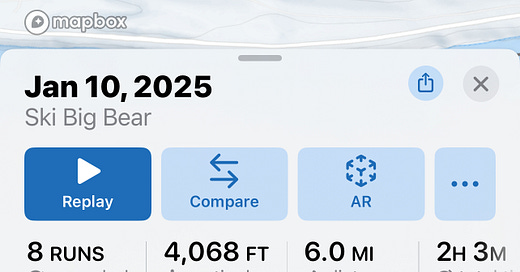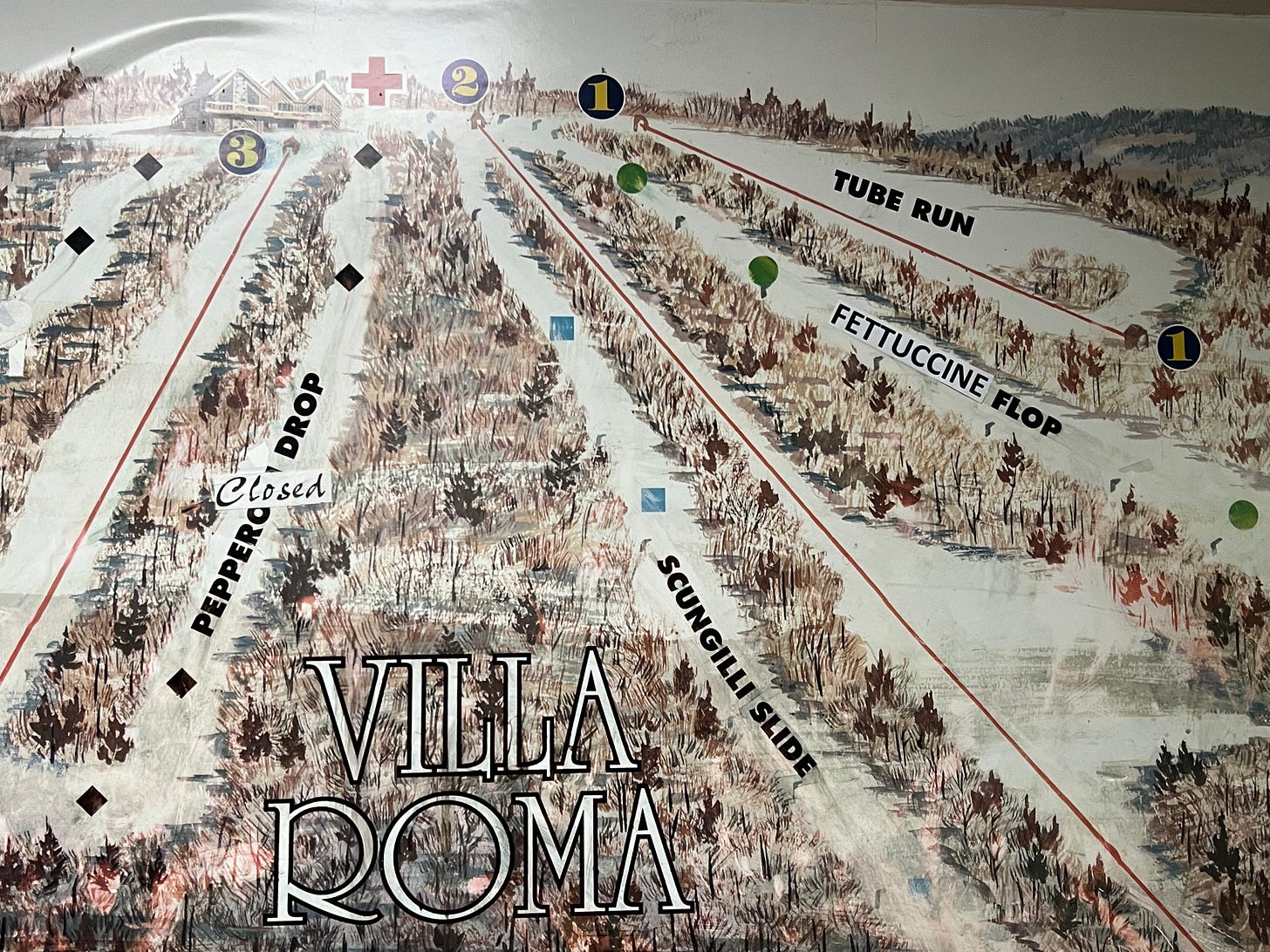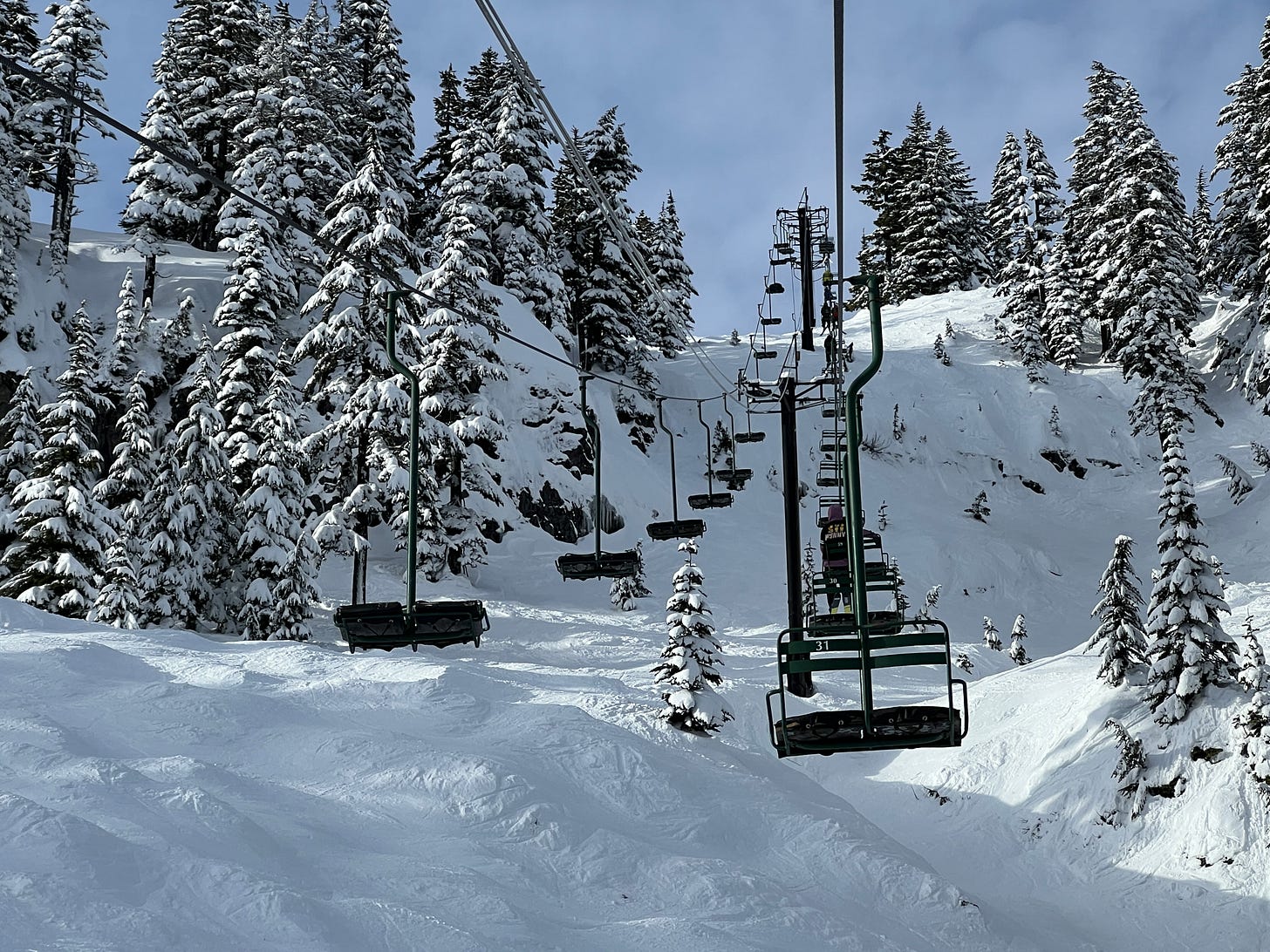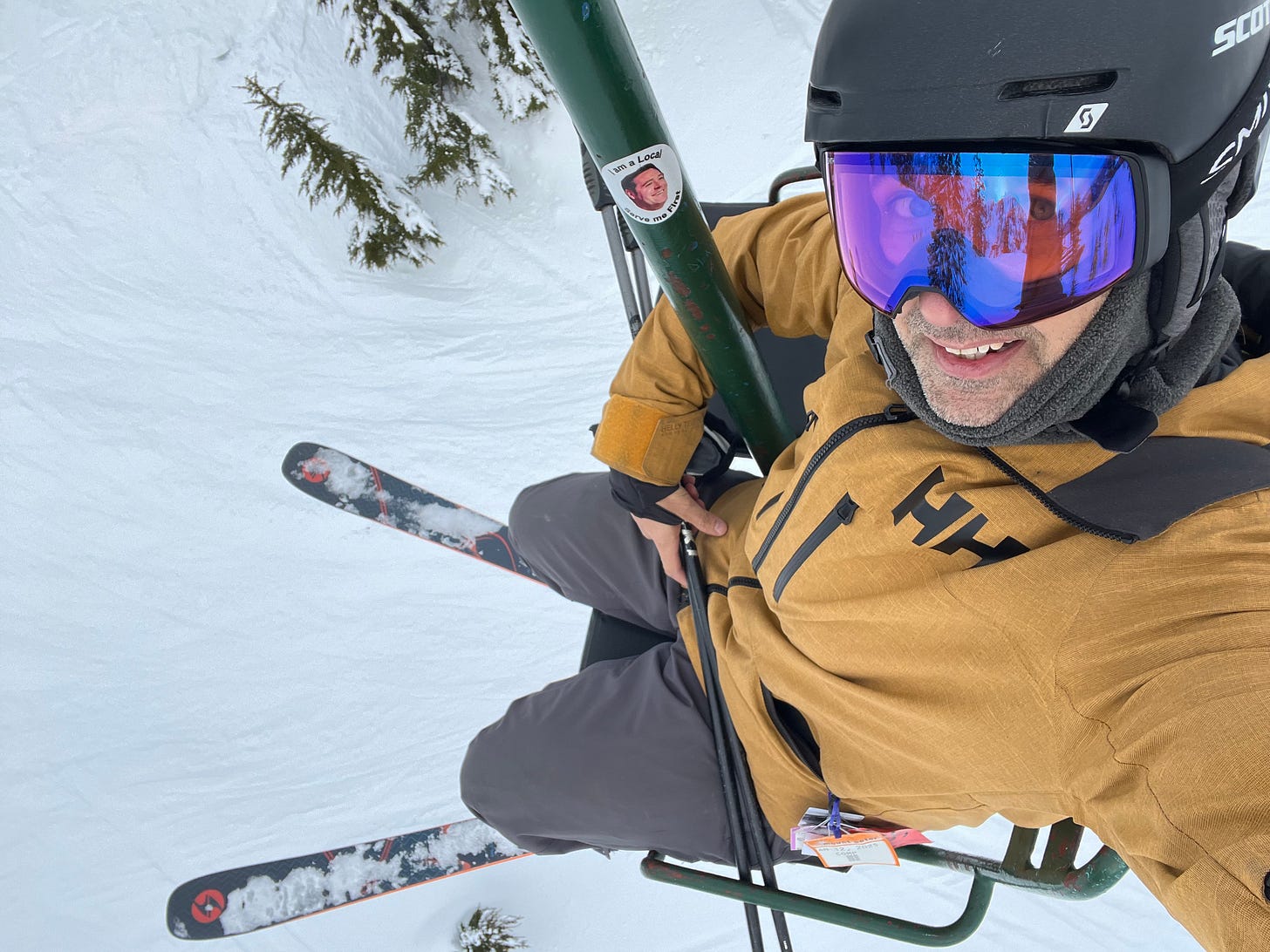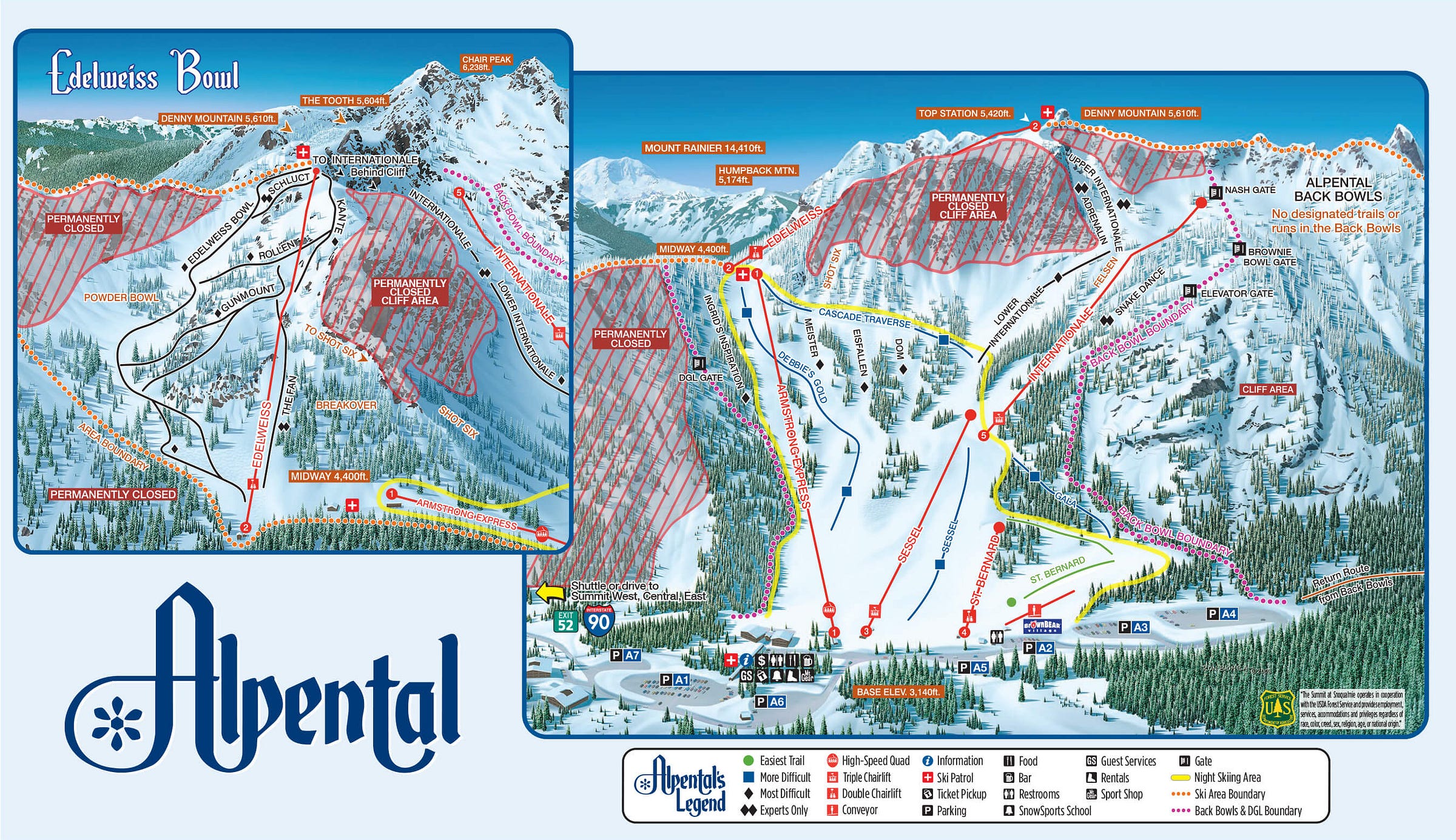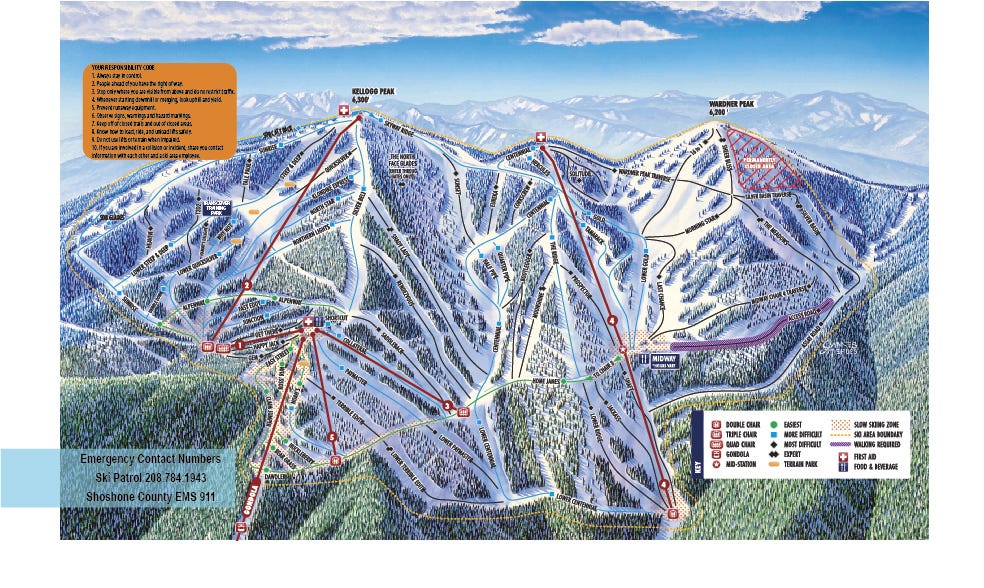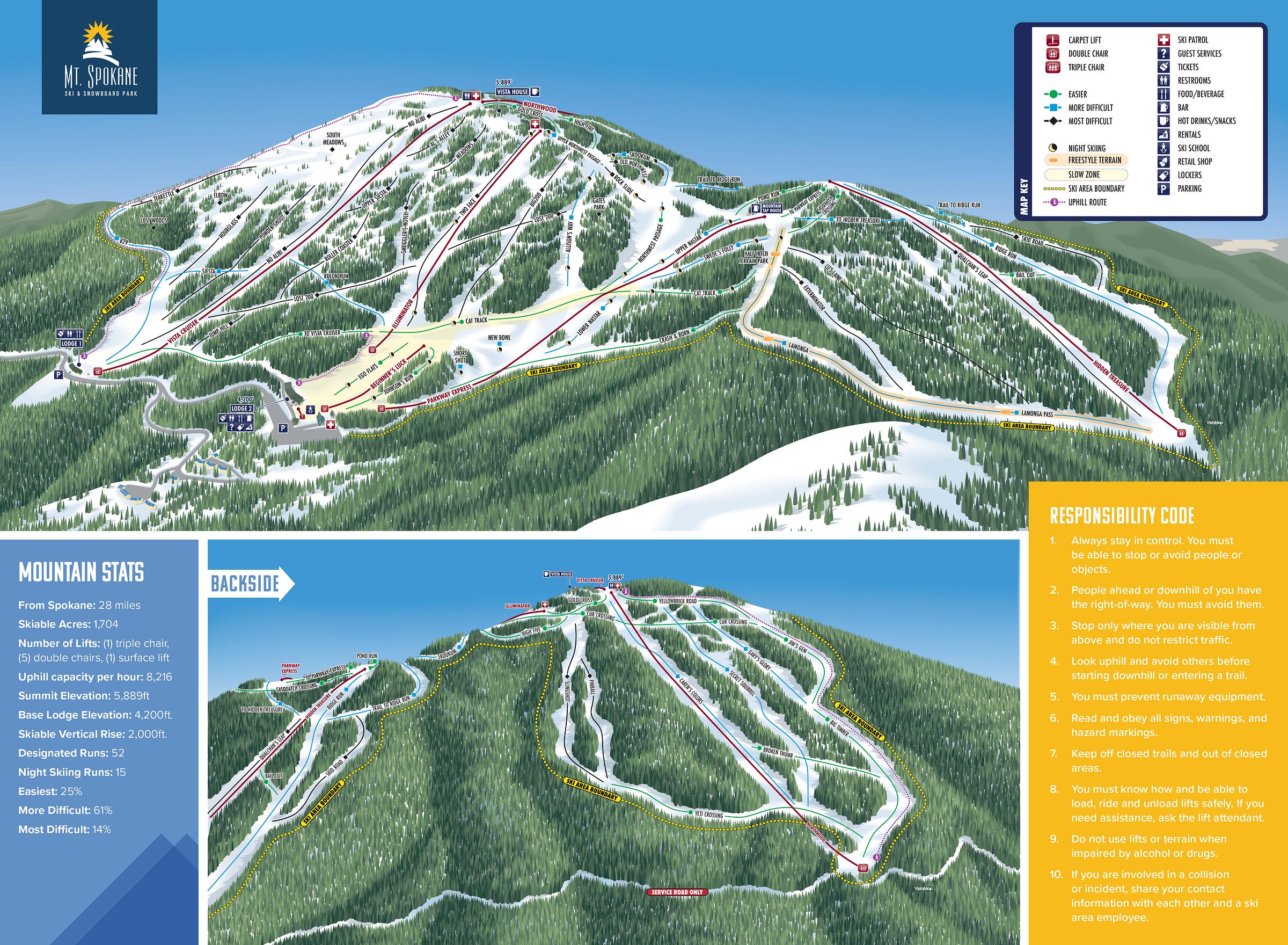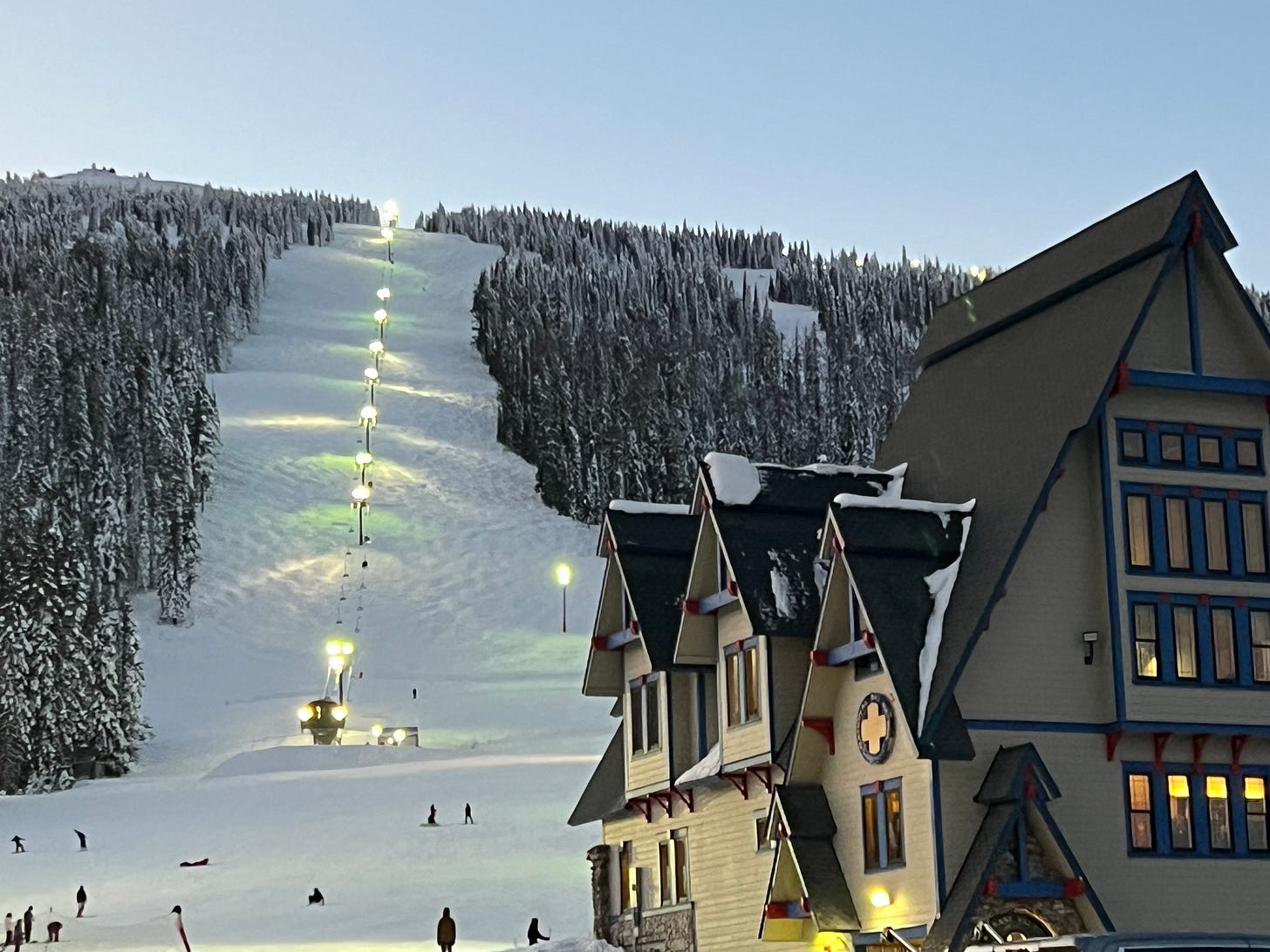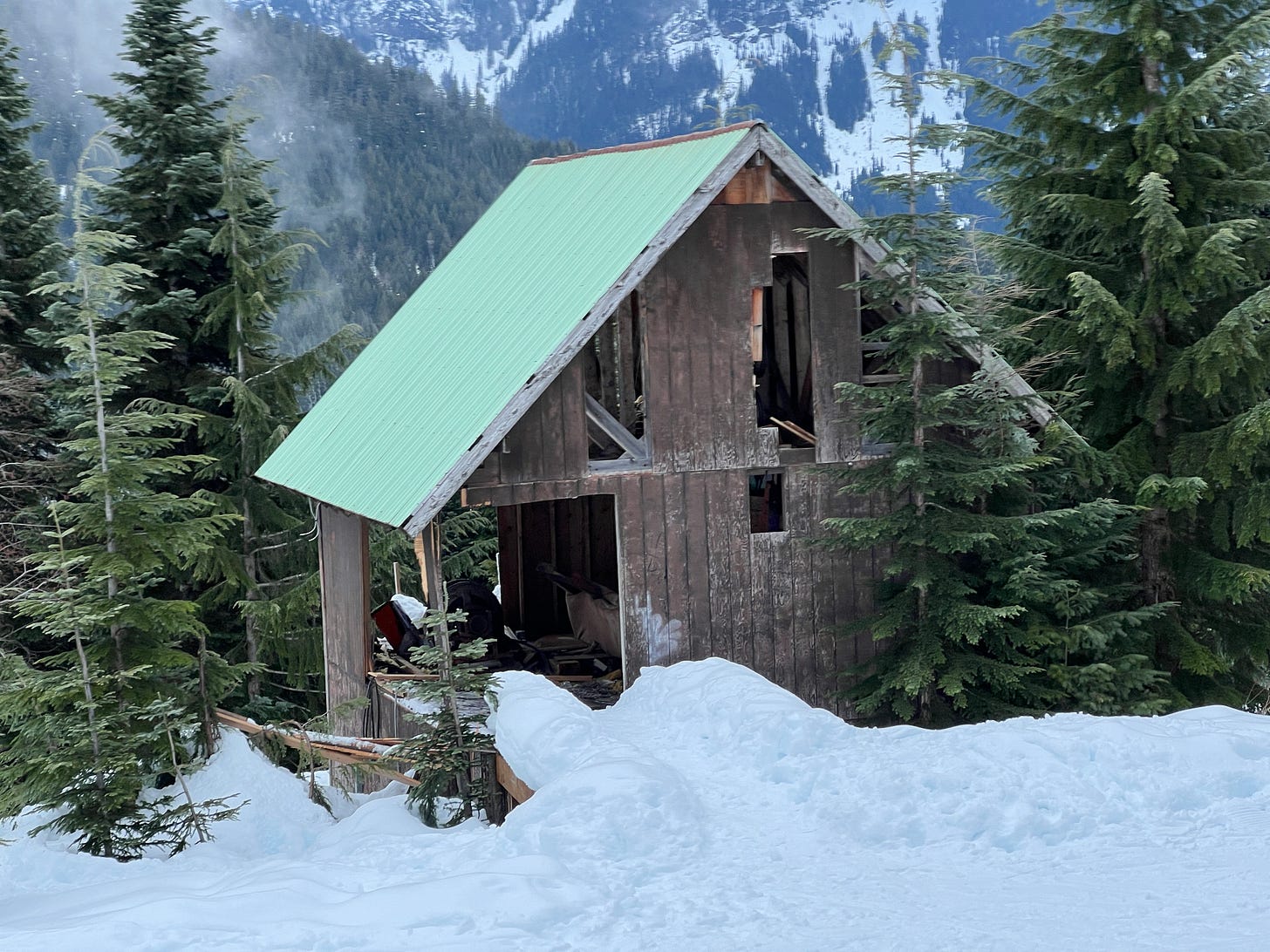Big Bear (Not That Big Bear), Weird Resorts, Idaho, Washington – January in Skiing, With Slopes
Claim your free year of Slopes Premium now
The Storm is partnering with Slopes* to document my 2024-25 ski season. Record your own story with a FREE YEAR OF SLOPES PREMIUM (a $29.99 value), when you upgrade to The Storm’s paid tier (allow up to 72 hours for your Slopes code to arrive via email).
Try the app first by claiming a free day pass from your mobile device.
*Slopes has no editorial input into these posts, which have been a regular part of The Storm’s content for years.
Friday, Jan. 10 – Big Bear (not that Big Bear), and some strange outliers
Ski Big Bear, Pennsylvania
If you leave early enough and with a full tank of gas, you can reach 28 public ski areas within a two-and-a-half-hour drive of New York City. This snowmaking-heavy asteroid belt runs roughly from Connecticut’s four ski areas, north through southwest Massachusetts (Catamount, Butternut, Otis Ridge), west to the Catskills, and south through the Poconos and New Jersey all the way to Spring Mountain, a speedbump just north of Philadelphia. Through habit or circumstance, I’ve skied some of these (Belleayre, Mountain Creek, Hunter), dozens of times. Others (Mount Southington, Bear Creek, Otis Ridge), I’ve only swung through once. But there were three that I’d never been able to work in. This annoyed me because they were right freaking there. So I blocked off a day.
Two of the three are tiny, obscure, and semi-functional. But Ski Big Bear is none of these things. It’s a 650-footer with four chairlifts and a staircase trail network hooking and rolling through the forest. The trails are not steep, but they are interesting. Like many Poconos ski areas, Big Bear is part of a gigantic housing development. Unlike most of those others, this one is open to the public, and it is on the Indy Pass. On weekends Big Bear teems with New Yorkers, trails packed like bunched racecars on a concrete loop, but on weekdays it’s empty parking lots, empty trails, empty lifts. The snow ran hard and fast in the cold January morning.

That this ski area shares a name with Alterra’s Los Angeles-adjacent Big Bear megaplex is unfortunate, mostly because the coincidence makes the Pennsylvania mountain nearly impossible to talk about without inserting awkward qualifiers. But I’ll have a lot more to say after Team Ski Big Bear at Masthope Mountain - as the bump is officially known - joins me on the podcast in a of couple months.
Skytop Lodge, Pennsylvania
One reason that it’s so hard to count how many ski areas exist in America is because some of them aren’t very good at being ski areas. This is one of them. I found Skytop by accident, a few summers ago, rambling between lost Poconos ski areas – stacked Pomas glanced in a mountain cut as I blew past on PA-390. What the hell? An uncharted island. Stapled, loosely, to a resort down the street. Open to the public, though no one I knew had ever heard of the place.
I’d confirmed, via Facebook message and after tunneling through Skytop’s vast matrix of untended phone lines and email inboxes, that the ski area would be open on this Friday from 10 to 4. I arrived at 2:30. I was the first skier all day. The kid behind the counter looked at me as though I’d made a mistake. They’d torn out the lift, he informed me, but this fellow over here would drive me up in a side-by-side. I paid $20 for the lift ticket and the kid piloted me uphill like some kind of rogue Poconos cat-skiing operator. I lapped the two empty and still-groomed runs, past odd little buildings and the ghosts of onetime ski trails. There was no ski patrol.
It was all a little weird and all a little cool. I made an Instapost video because I am trying very hard to be Relevant:
Villa Roma, New York
The Catskills were once filled with vacation resorts, and many of them maintained little ski areas. Most of these resorts died with the advent of air travel, and their little hopscotch ropetow outfits died with them, but somehow Villa Roma remains. And it has a ski area with a chairlift rising 190 vertical feet. Modest, but if you approach from the south, along Reum Road, etched high on a hillside across the valley, the trails tower over the resort buildings like some mini-Telluride.
Like Skytop, Villa Roma is an online ghost. A Facebook DM suggested, but did not confirm, that the chairlift would be spinning. The place is so obscure that Google Maps was unable to guide me to the parking lot, which is two turns down narrow roads snaking above the resort, at the top of the lift.
Plenty of people up there, mostly tubers. But it is impossible to understand how the ski area is a functional entity. The resort has abandoned most of what was once a much-larger ski area. This undated map still hangs on the baselodge wall:
Lift 3 was a T-bar. Lift Blog photographed this machine in some recent summer, but says that the lift has since been removed.
But, still, skiing. A Borvig spinning out of a timewarp. Teenagers all over, laughing in the Friday chill. Two trails open. Darkness falling. A lovely liftline ride through the trees. But it was cold and I was tired and the lift-op with questionable dental work seemed ready to ask me if he could bum a smoke. So three runs and out. I’d seen enough.
Sunday, Jan. 12 – Mt. Peter, New York
For years Mountain Creek was my weekend quick-hitter, with its thousand-feet of vert and high-speed lifts. But for the past few winters my 8-year-old son has been in a seasonal program at Mt. Peter, about the same distance from Brooklyn as Mountain Creek and about one-tenth the size, 275 vertical feet, three chairlifts, three carpets, and what feels like 8,000 kids. It is one of the better ski learning centers that I’m aware of anywhere. A lot of parents say “p-shaw I am just sticking the kids here so I can take them to Breckenridge for Presidents’ week, so I will get wasted in the bar or fiddle around on my phone while they ski,” but I say “Oh look a snosportskiing area I’ll do that.” Usually I ski alone but on this day another of the dads was skiing and so we lapped the double chair and talked about Dad Stuff like real estate and the death of physical media and what New York City was like before we had to ensure that small people entrusted to our care had adequate supplies of food. He is not an avid snosportskier like I am but he’s learning it because he wants his kids to have something to do in the wintertime and I think that’s really damn cool.
Monday, Jan. 13 – Alpental, Washington
Every long-lasting marriage endures on a set of compromises and here is one of mine: I have a four-day travel window each winter month to explore America’s ski areas, connect with the people running them, and generally grow The Storm’s reach and knowledge base while my wife makes sure that the kid goes to school and stuff. Since the East is all day-trippable and mostly familiar I tend to go west, to plan well in advance, to chase regional density over conditions. Sometimes I get lucky and it snows. This wasn’t one of those times.
Perhaps for the better. Clear skies all four days and Pacific Northwest views rolling into infinity. I flew into Seattle, where it snows an average of six inches per winter. Less than an hour east is a complex of four formerly-separate ski areas where it snows 428 inches in an average winter. It snows so much and so reliably that the resort has no snowmaking (except one gun for tubing). Three of the four historic areas rise up to 1,100 interconnected vertical feet above Interstate 90, an Ikon Pass circus for metro Seattle’s 4 million people. But the fourth ski area stands alone across the interstate, 2,280 vertical feet of labyrinthian freefall called Alpental.
Alpental covers just 875 acres, small for an Ikon ski area but a bit larger than Aspen Mountain. No one outside of Washington seems to understand what this place is, or that it exists at all. But this may be the best small ski area in the country, a towering little-groomed freeride playground, fierce and unforgiving, abrupt and menacing. On the approach road I looked skyward and thought the GPS had made a mistake, because how the hell did they even put lifts up the terrain materializing before me?
My flight had landed late and I wasn’t booted and riding uphill until around 2:00. Still, enough time to move around, to ride Chair 2, a 1967 Riblet double, to the summit, and to stand on that summit and say “gosh.”
That lift is tagged for the Dumpster. Boyne owns this joint, and as they gut-renovate their portfolio, a new Doppelmayr triple will rise on that line this summer, the third new lift at Alpental in as many years. The second one – a brand-new line up existing terrain called Internationale – went in for this winter:

You may be wondering, since I am Chairlift Bar Bro, how I managed to ride this thumbtack-as-transportation device uphill, and here is my make-your-own-bar hack, taught to me by a patroller at Mt. Baldy, California a few seasons ago:
Alpental is one of those crazy multi-faced mountains that can be hard to make sense of on a trailmap. Check it:
This is where Slopes is awesome, because you can adjust the onscreen angle as you replay your day in 3D:
The snow was marginal, beat-up and refrozen down low, and I skied slow and deliberately. The lifts closed at four. I exited onto I-90 and drove my gigantic rented Ford Expedition to Spokane.
Tuesday, Jan. 14 – Silver Mountain, Idaho
It’s hard to believe that Silver Mountain exists: directly off an interstate exit, a parking lot the size of Connecticut, a three-mile-long gondola to the lifts, 2,200 vertical feet, 1,600 acres, 340 inches of average annual snowfall, glades all over, steeps all over, empty. A $73 midweek lift ticket, $79 on weekends (it’s also on Indy Pass). Vast, gorgeous, cloud-locked, a singular experience, stuck all the way up here, where no one’s bothering to look, in the Idaho panhandle.
This is another ski area that doesn’t make a lot of sense on the trailmap:
It’s not obvious from the trailmap, for example, that a skier could turn left off Chair 2 and ski down to Chair 4. Slopes to the rescue:
The ski area’s lifts are dated but who cares? Silver is magnificent, the sort of varied wanderland that rewards imagination and patience. You can hike that far peak if you want to. I didn’t. What I could get to was enough, and I barely got to anything.
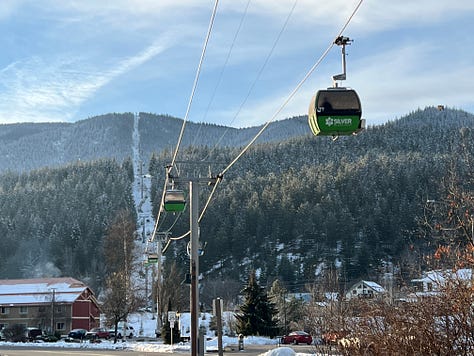
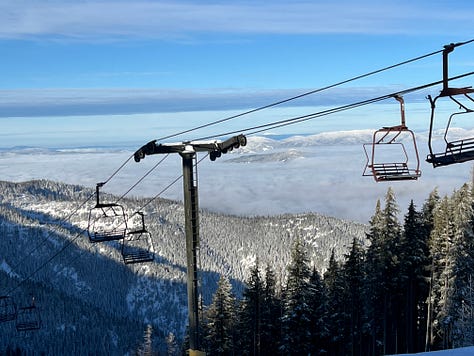

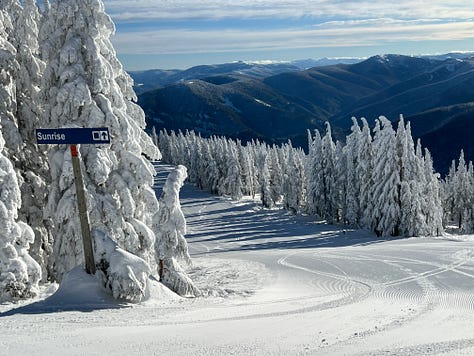
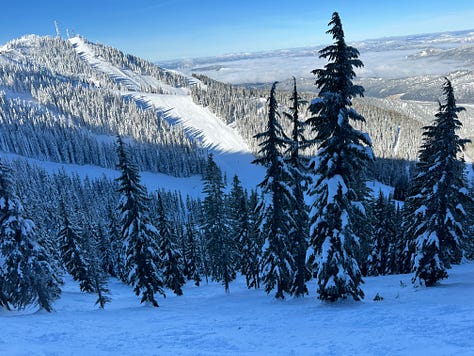
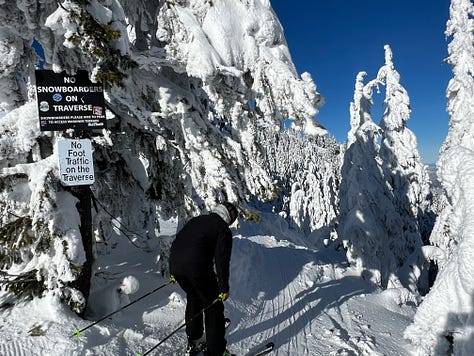
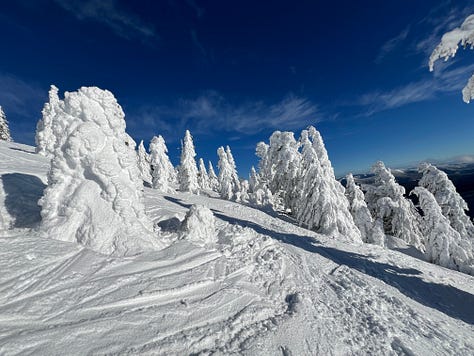
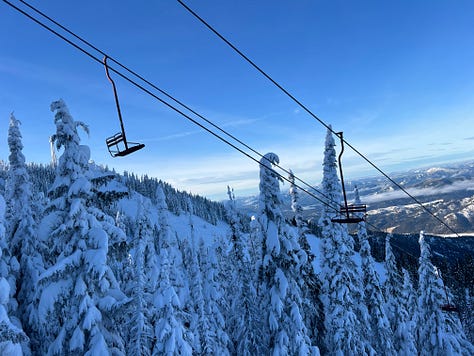
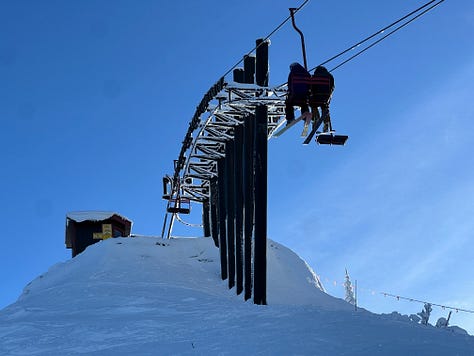
Wednesday, Jan. 15 – 49 Degrees North and Mt. Spokane
49 Degrees North, Washington
Silver and 49 North share an owner, but the latter is parked at the top of a mountain pass, snow-smeared still several days after the last storm. At 2,325 acres, the mountain is vast, the second-largest in Washington, rolling over terrain pods cut in waves over 49’s decades-long evolution. In 2021, the new owner, Tryg Fortun, ran a high-speed quad up the ski area’s 1,847-foot vertical drop, replacing a slow-moving SLI double chair and transforming the mountain’s profile and skiability. Skier visits have approximately doubled since.
There’s still almost no one there. Comfortable carrying capacity is around 4,000 skiers per day, a fraction of what you’ll find at similarly sized resorts in Utah and Colorado. On weekdays, the number of skiers is a fraction of even that. No lines. Almost no one on the trails. So many trees, typically my favorite, but this was mostly a groomer day, so outstanding was the cord. Streaking all over. Little terrain pockets all over, like 10 little ski areas mashed together into a gigantic one. Nearly 24,000 vertical feet even though I bounced by three.
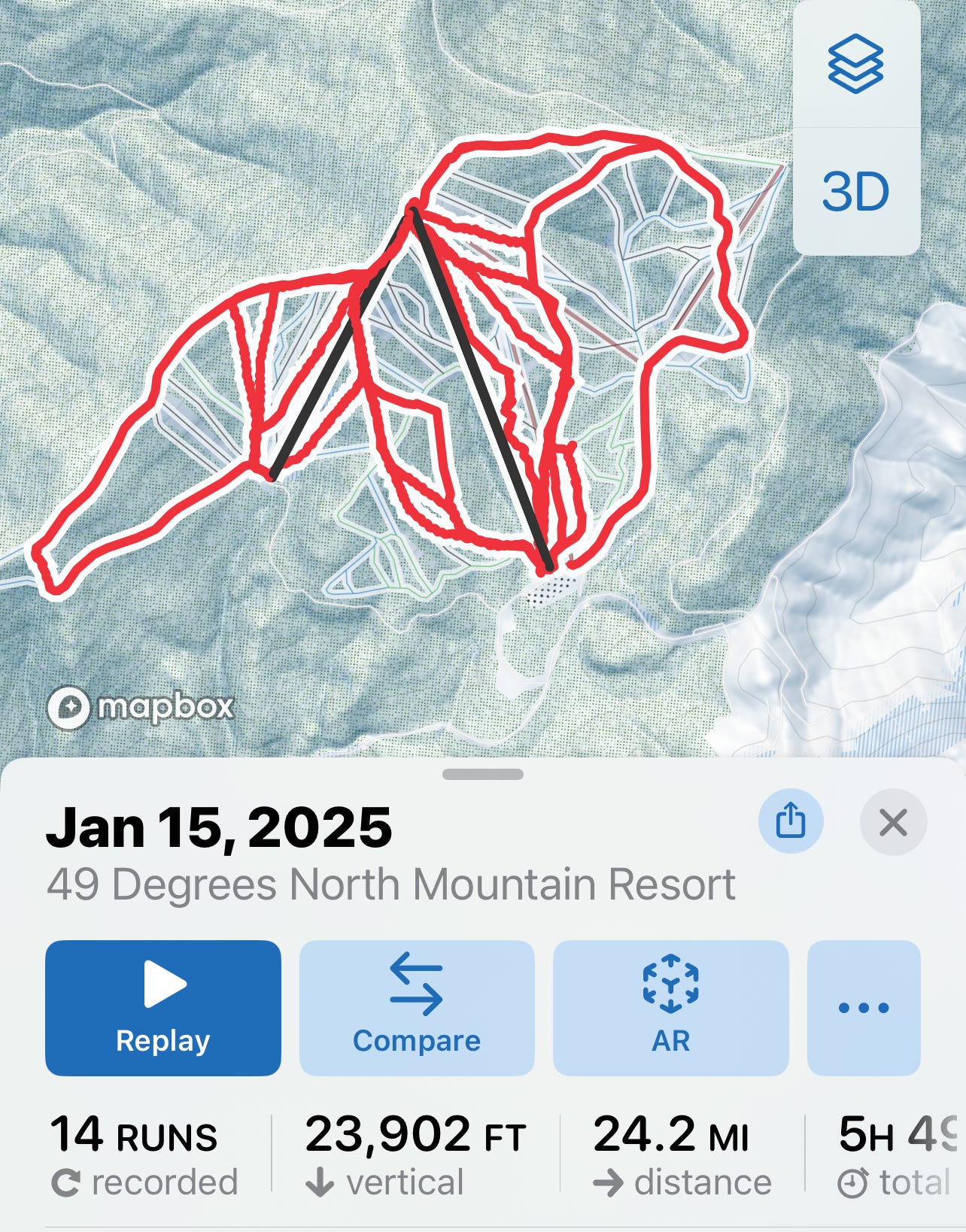
And gorgeous:
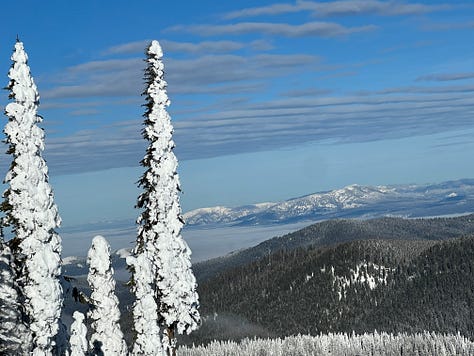
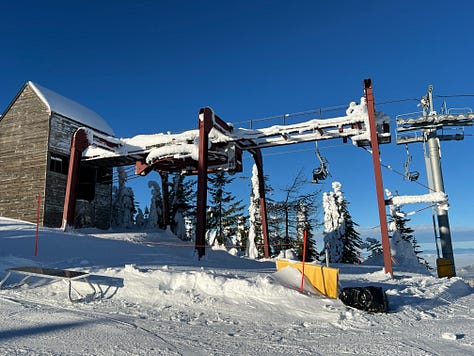
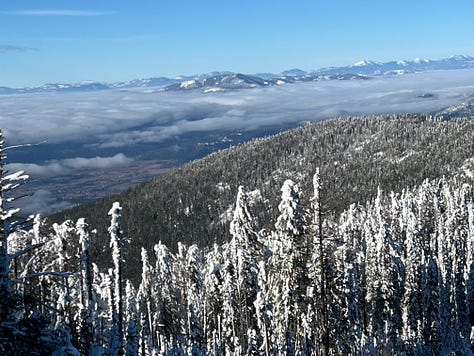
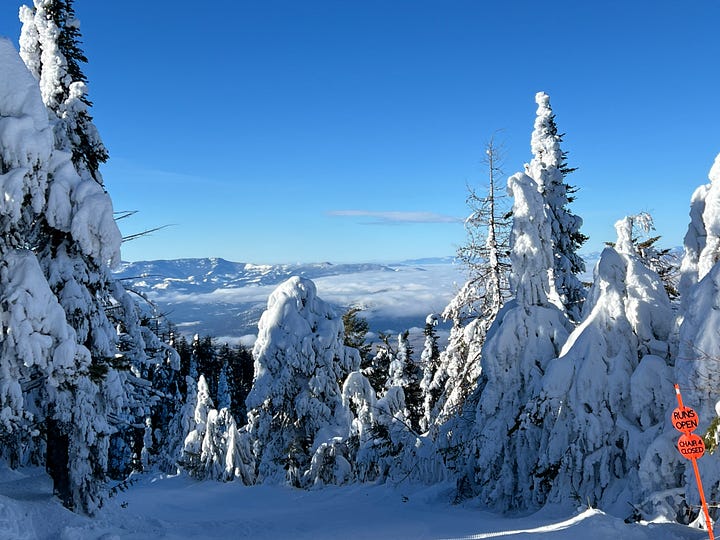
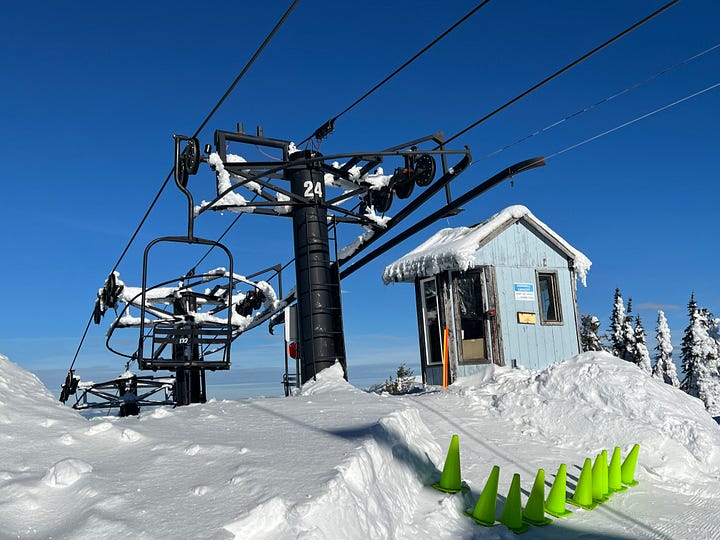
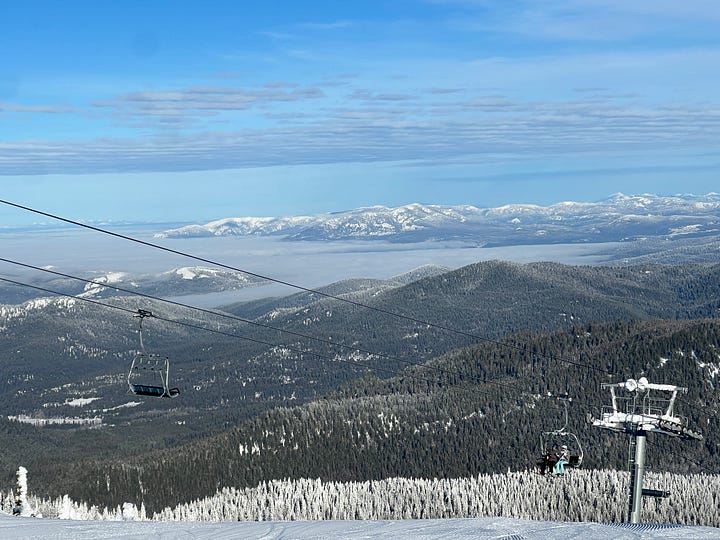
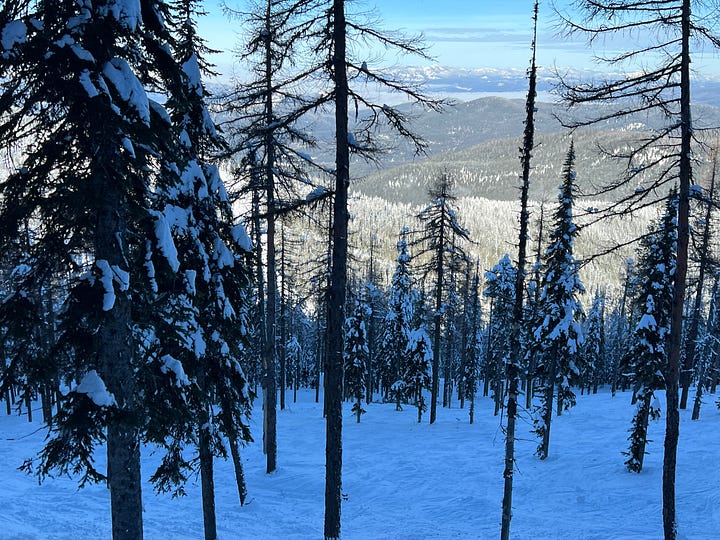
Mt. Spokane, Washington
Thirty air miles and 73 road miles southeast of 49 Degrees North is Mt. Spokane, five Riblet doubles spinning up 1,704 vertical feet at the top of a whipsaw access road. Chair 1 dates to 1956, Chair 2 to ’61. The rest arrived in the ‘70s, followed by a 2018 backside expansion with a Skytrac triple.
At night only the center of the map is open, where three doubles cluster around a big central meadow. Rowdy steep bumps beneath Illuminator. The kids mostly lapping Parkway, at the top of which runs a new terrain park handle tow, a weird little thing I’d never seen before, a Sunkid lift that can drag you or pull you or tow you with little Poma-type between-the-legs buttons:
The snow had stayed fresh. No ice. Easy carving. Kids on the chairlift singing 1980s rap songs. College vibe. Big groups skiing around. Just fun, man.
Thursday, Jan. 16 – Summit at Snoqualmie, Washington
I flew in and out of Seattle so I could ski a half day on either end, and the second half-day was a morning burner at Summit Central. Laps off Silver Fir. Bumps the size, shape, and hardness of bunched igloos. Groomers below. Lifts all over. Some fast. Some slow. Some predating the written word. That Alpental has no snowmaking is curious; that Summit has none is baffling. But it doesn’t and it doesn’t matter, because there at 2,800 feet is snow piled bonkers high even in January. Check the crazy lift assortment:
On this Thursday morning only Central had opened, but my guide led me on the new-and-improved cross-trail to Summit West:
Where we got a view of the brand-new, realigned Wildside lift, a rare new fixed-grip quad in Boyne’s fleet:

On the crossover back to Central we passed this old tow shack, part of the defunct Mountaineers Club, onetime stewards of the fierce short pitch above. This building is coming down next summer, I’m told, as this rattly, rambling boat awkwardly christened “The Summit at Snoqualmie” floats toward the modern world.

